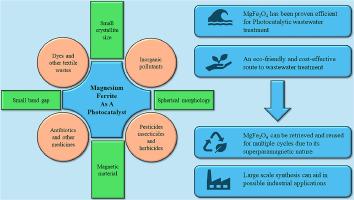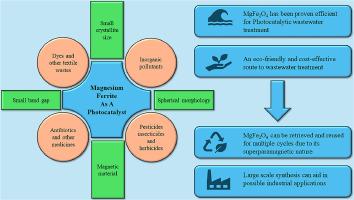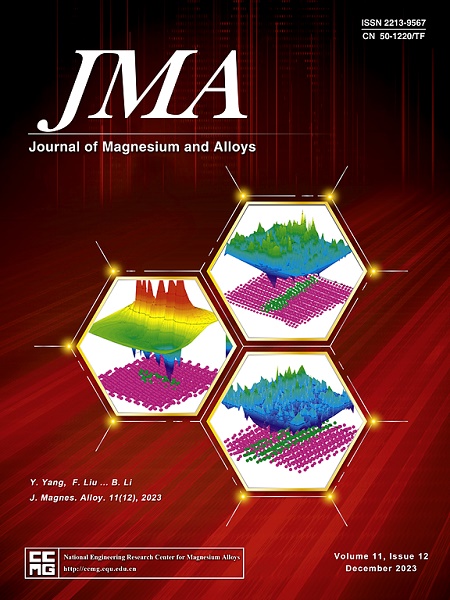基于铁氧体镁及其复合材料的光催化剂:用于废水修复的光催化性能的合成方法、掺杂效果和操作参数
IF 15.8
1区 材料科学
Q1 METALLURGY & METALLURGICAL ENGINEERING
引用次数: 0
摘要
近年来,越来越多的有毒废水排入水体,严重危害了生态系统和人类福祉。人们采用了各种技术来清除污染物,其中光催化技术已被证明是最环保、最有效的技术。由于 MgFe2O4 的带隙小、球形、磁响应性、稳定性、可重复使用性、成本效益和结晶尺寸小,因此它是一种特殊的光催化剂。我们对过去十年的研究进行了全面的比较和评估。纯、掺杂和复合形式的镁铁氧体的光催化潜力。同时还详细解释了合成方法、降解机制和缺点。此外,我们还强调了掺杂的 MgFe2O4 及其纳米复合材料在可见光照射下,在相对较短的时间内对各种有机污染物的光催化能力。讨论了阳离子分布、用量、pH 值以及回收和再利用方法等因素,以帮助生产更高效的光催化剂。目前还缺乏有关可用于克服 MgFe2O4 铁氧体各种缺点的技术的信息。因此,我们着重提出了这些先进技术,它们将有助于推动研究人员关注混合 MgFe2O4 纳米粒子的实际和工业应用。最后,我们对 MgFe2O4 铁氧体基材料的研究空白和工业需求进行了探讨,以提供一个简明的观点。本文章由计算机程序翻译,如有差异,请以英文原文为准。


Magnesium ferrites and their composites based photocatalysts: Synthesis approaches, effect of doping, and operational parameters on photocatalytic performance for wastewater remediation
In recent years, increased discharge of toxic effluents into water bodies has severely harmed ecosystems and human well-being. Various techniques are employed to remove contaminants, among which photocatalysis have proven to be the most environment friendly and effective technique. This review focuses on MgFe2O4, an exceptional photocatalyst owing to their small band gap, spherical shape, magnetic responsivity, stability, reusability, cost-effectiveness and small crystallite size. We have covered comprehensive comparison of research studies from the past decade to assess. Magnesium ferrite's photocatalytic potential in pure, doped, and composite forms. Along with synthesis methods, degradation mechanisms, and shortcomings explained in detail. Furthermore, we have highlighted the enhanced photocatalytic capability of doped MgFe2O4 and their nanocomposites towards the various organic contaminants upon visible light irradiation under a comparatively short period of time. Factors like cation distribution, dosage, pH, as well as methods for recovery and reuse are discussed to aid in production of more efficient photocatalysts. There has been a lack of information on the techniques that can be used to overcome the various shortcomings of MgFe2O4 ferrite. Hence, we have accentuated on bringing forth such advanced techniques that would aid in driving the researchers’ attention towards the practical and industrial application of the hybrid MgFe2O4 nanoparticles. Lastly, the research gaps and industrial need of MgFe2O4 ferrite-based materials were addressed to offer a concise view.
求助全文
通过发布文献求助,成功后即可免费获取论文全文。
去求助
来源期刊

Journal of Magnesium and Alloys
Engineering-Mechanics of Materials
CiteScore
20.20
自引率
14.80%
发文量
52
审稿时长
59 days
期刊介绍:
The Journal of Magnesium and Alloys serves as a global platform for both theoretical and experimental studies in magnesium science and engineering. It welcomes submissions investigating various scientific and engineering factors impacting the metallurgy, processing, microstructure, properties, and applications of magnesium and alloys. The journal covers all aspects of magnesium and alloy research, including raw materials, alloy casting, extrusion and deformation, corrosion and surface treatment, joining and machining, simulation and modeling, microstructure evolution and mechanical properties, new alloy development, magnesium-based composites, bio-materials and energy materials, applications, and recycling.
 求助内容:
求助内容: 应助结果提醒方式:
应助结果提醒方式:


